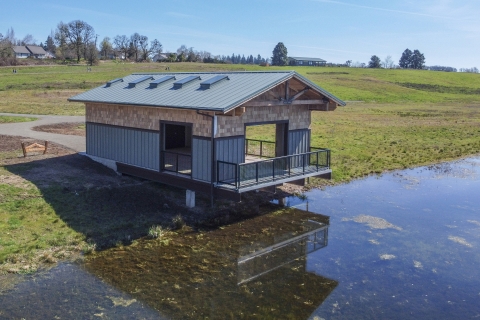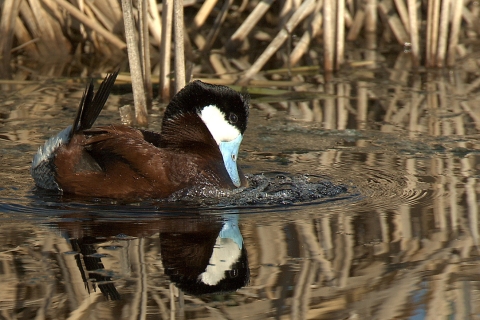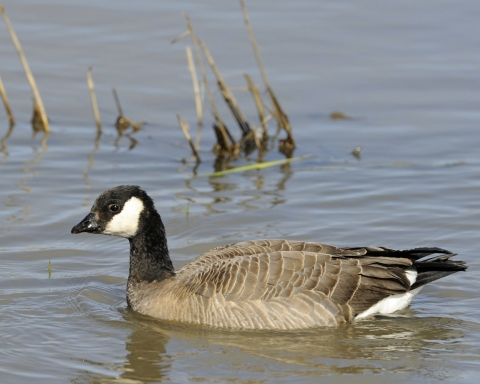By Jan Peterson, for the U.S. Fish and Wildlife Service
The David B. Marshall Outdoor Classroom at the Ankeny Hill Nature Center, part of Ankeny National Wildlife Refuge, is a place for the community to learn about nature and participate in environmental education programs that anyone can access, and where everyone is welcome.
The project is the culmination of a collaborative project by the U.S. Fish and Wildlife Service, Salem Audubon Society and the Friends of the Willamette Valley National Wildlife Refuge Complex, which includes Ankeny, William L. Finley and Baskett Slough refuges.
Megan Nagel, who supports refuges in her role with the Service’s Pacific Region Office of Communications, explained the vital role our nation’s system of refuges play in the survival of endangered species.
“The refuge complex serves as an important stopover site for birds since time immemorial,” Nagel said. “The three refuges have contributed to bringing the dusky Canada goose back from the brink of extinction. This is an example of how conservation and protected places like refuges can prevent a species from being listed under the Endangered Species Act. The refuges also collectively help prevent depredation of neighboring agricultural crops by drawing migrating and overwintering birds to the public lands. The refuges are some of the last remaining sites for restoring and protecting remaining threatened and endangered species from fish to butterflies to plants.”
Marshall was born in 1926 in Portland to a pioneer Oregon family that included a number of naturalists. His family was among the first European settlers to cast eyes on the bountiful Willamette Valley. A place of plentiful fields and forests - ideal for a great diversity of wildlife. The Kalapuya people managed this land and the prairies long before those first pioneers arrived - and still do today as part of the Confederated Tribes of the Grand Ronde.
Marshall’s great-grandmother was friends with famed conservationist, wildlife photographer, writer and naturalist William L. Finley, for whom one of the refuges is named. “Some of my earliest memories are identifying birds in the backyard at the feeder,” Marshall recalled in an oral history conducted by the U.S. Fish and Wildlife Service after his retirement. “I learned their names from my mother and father,” he said, noting his parents were members of the Oregon Audubon Society, which is now Bird Alliance of Oregon.
With his family, Marshall explored and camped throughout the region, and as a child witnessed important conversations in the early years of conservation. “I would overhear them talking over conservation problems and their strategies and what they should do about various issues,” Marshall said, noting there were conversations about the need to protect endangered species as early as 1937, long before the passage of the Endangered Species Act in 1973.
Marshall was just a kid visiting Steens Mountain, Oregon, with his dad, Earl, when he grasped the importance of protecting species from extinction. “We looked down at the fish in (Borax Lake) and my father told me, ‘That fish does not have a name, and this is the only place that it is found in the world.’ Somehow, that really got to me. I picked up a lot of interest then. This fish didn’t have a name, and this was the only place in the world where it was found.”
The fish later became known as the Borax Lake chub. It was listed under the ESA in 1982 and after successful conservation efforts was delisted in 2020.
Marshall landed his first role with conservation in 1943, while still in high school. At the age of just 17 (nearly all physically fit adult males were serving in World War II) Marshall and friend Tom McAllister were each placed in remote fire lookout stations on peaks in the Fremont National Forest. “We were put up there alone with no contact with the outside world except by telephone connected to the nearest ranger station,” said Marshall.
This isolation paid major dividends. Marshall and McAllister had plenty of time to observe birds, keep notes and collaborate on their observations. Their article, “Summer Birds of the Fremont National Forest, Oregon,” was published in The Auk, the journal of the American Ornithologists’ Union, before either of them had even completed high school.
After serving in the U.S. Army Air Corps in World War II, Marshall returned to a summer job as a fire lookout and began his studies in Fish and Game Management at Oregon State University. “We were the first postwar class at Oregon State in Fish and Game Management,” Marshall said.
After short stints with the U.S. Forest Service and U.S. National Park Service, embarked on his career with the U.S. Fish and Wildlife Service as first as a student intern and then as an assistant refuge manager at Stillwater National Wildlife Refuge, in Fallon, Nevada, in 1950. During a childhood visit to Malheur National Wildlife Refuge, Marshall was inspired to work for the agency after meeting biologist Stan Jewett, who was his first supervisor with the agency.
Marshall’s career took him through several refuges including Malheur National Wildlife Refuge before he took a position at the Pacific Regional Office in Portland. Among his responsibilities: Helping to select lands in the region for refuges. It’s an issue he started thinking about while still at Malheur, when he spotted a memo asking for recommendations. “I nominated sites which now constitute the William L. Finley and Baskett Slough refuges in the Willamette Valley,” he said in his oral history.
Regarding the establishment of the three national wildlife refuges in the mid-Willamette Valley in 1964 and 1965, Marshall said he knew about Ankeny but initially discounted it because “there wasn’t any goose use at Ankeny … but I did see the potential and I thought there could be significant goose use there. Maybe I was gambling, but I felt with minimum wetland development, geese would use that area, and it’s turned out to be very successful. So, I am happy about all three of those areas.”
Marshall’s career with the Service took him to Washington, D.C., and landed him a role in the Office of Endangered Species and Foreign Activities. He played a key part in developing the first endangered species lists and the Endangered Species Acts of 1966, 1969 and 1973.
After retiring from the Service in 1981, Marshall continued to advocate for bird conservation measures and worked as a consultant to the Oregon Department of Fish and Wildlife. He co-authored the reference book “Birds of Oregon” with Alan Contreras and Matt Hunter. He died at the age of 85 in 2011.
Nagel says the outdoor classroom named in Marshall’s honor at the 2,800-acre Ankeny National Wildlife Refuge will help future naturalists by providing them with a space to learn and enjoy their natural world, hopefully inspiring the next generation of conservation stewards. Just as Dave Marshall was inspired by the birds of the Willamette Valley and Malheur National Wildlife Refuge.
Wildlife conservation is at the heart of the National Wildlife Refuge System. It drives everything on U.S. Fish and Wildlife Service lands and waters managed within the Refuge System, from the purposes for which a national wildlife refuge national wildlife refuge
A national wildlife refuge is typically a contiguous area of land and water managed by the U.S. Fish and Wildlife Service for the conservation and, where appropriate, restoration of fish, wildlife and plant resources and their habitats for the benefit of present and future generations of Americans.
Learn more about national wildlife refuge is established to the recreational activities offered to the resource management tools used. Using conservation best practices, the Refuge System manages Service lands and waters to help ensure the survival of native wildlife species.




